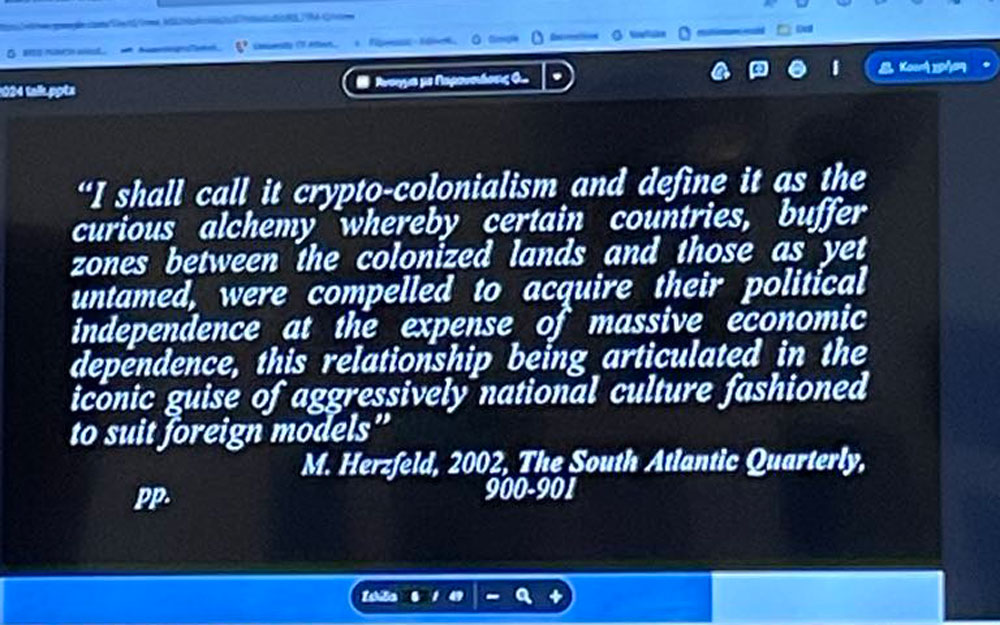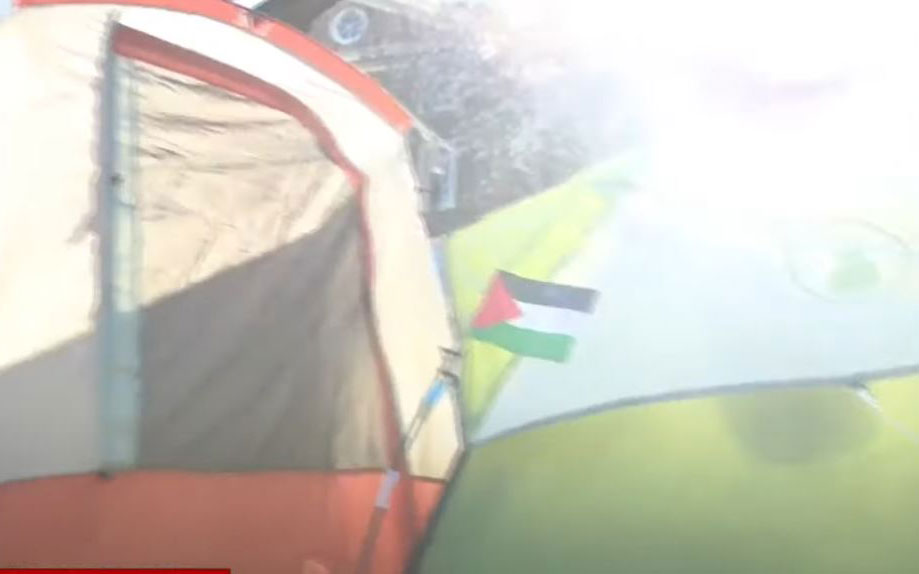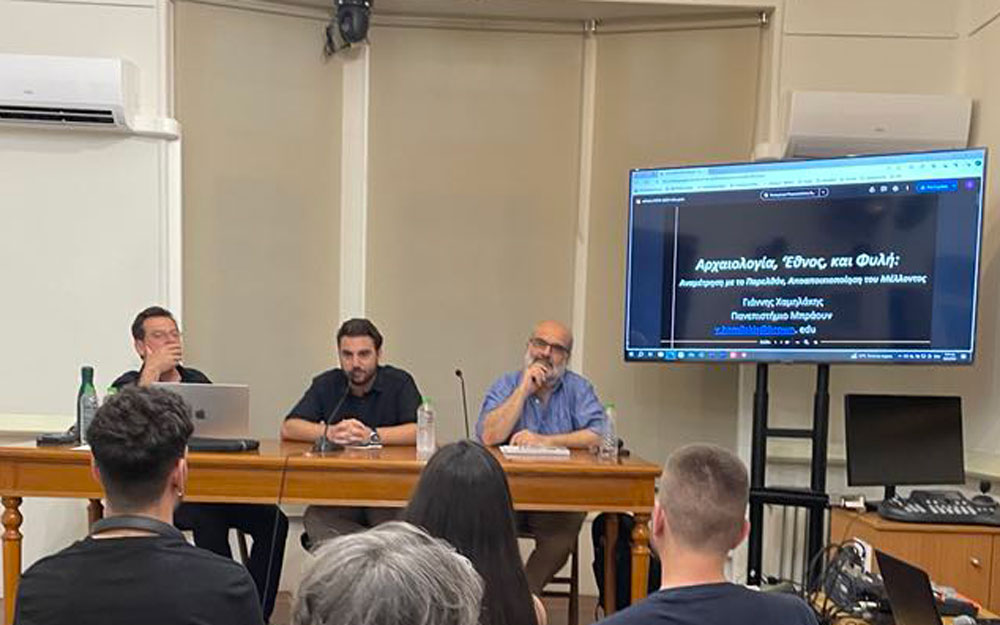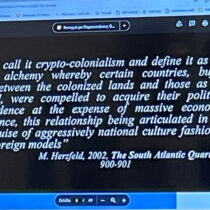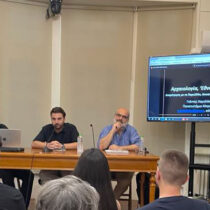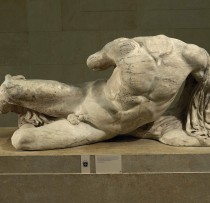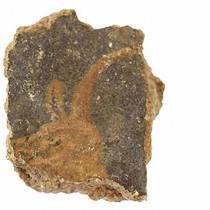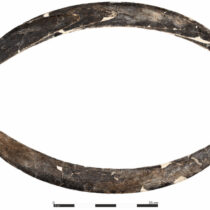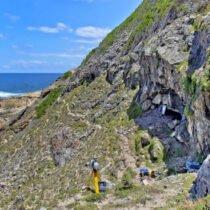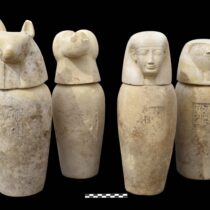“We grew up in a condition where the nation was non-negotiable.”
This is how University of Athens Professor Dimitris Plantzos introduced a joint presentation with Brown University Professor Yiannis Hamilakis, which was organized by the University’s own Association of Graduate Students of History and Archeology. The meeting’s theme was centered around the book “Archaeology, Nation and Race“, which Hamilakis co-authored with the Israeli professor at Tel Aviv University, Raphael Greenberg. The book, based on a seminar series by Hamilakis and Greenberg, analyzes how archeology is connected to the concepts of nation and race, through the study of Greece and Israel. Besides being the places of origin and activity of the two authors, Greece and Israel are seen as two countries with a parallel course in the use of the past as a binding material for their contemporary identity formation.
The collaboration between Hamilakis and Greenberg is the most recent stage of a research path spanning a little more than 40 years, which is changing archaeological epistemology. Through this path, archeology is found “in conversation” with other social sciences, revisiting concepts previously seen as “axioms”, and finally bringing scholars and the public against their certainties and sensitivities, aiming for a more honest consideration of what is happening in the world. Professor Plantzos narrated this process, defining it as its starting point B. Anderson’s book “Imagined Communities”. In this book’s first edition, for the first time, the nation is defined as an ontology and the result of a collective imagination. In a second edition of the same work (1991), however, an additional chapter highlights the role of archeology in the creation of these imaginary nations. This theory was contested by various schools of thought. If traditional historians did not accept the subjectivity of their constants, the so-called “post-colonialists” saw Anderson’s theory as an obstacle to the effort of recently decolonized groups to self-define themselves as nations in their quest for independence.
And, this is how we reach 2002, when M. Herzfeld formulated another intersectional term: the idea of cryptocolony, which concerns countries that were not colonies but form part of the sphere of influence of great powers/metropolises. Within the context of this influence, as Plantzos explains, these peripheral countries “consume the image that the metropolises construct for them”, using it as a tool in their quest for self-determination and freedom. One such example is modern Greece’s use of the image of classical antiquity or the epic of Alexander the Great in Asia, as shaped by European antiquarians and classicists during the Renaissance and the Enlightenment.
Based on the theories of imaginary communities and crypto-colonialism, the work of Yiannis Hamilakis examines issues such as the use of the material remains and antiquity as signs of Greekness and “whiteness”, as well as the issue of race. If there is any meaning to the study of all these issues through Hamilakis’s perspective, it is to avoid a kind of fake”archaism” in public discourse. It is this fake archaism that supports a false image of Hellenism held accountable for social conflicts and community marginalization.
At this point, Yiannis Hamilakis took the podium. Thanking for the invitation, he emphasized that this was the first time that the University of Athens had invited him to speak, stating that the primary idea for the discussion was to focus on the war in Gaza; a theme he would also tackle.
“Criticism rests first on reflection,” he continued. Our origin, our class, but also our position in archaeology. It was moving and enlightening to hear Hamilakis using his own story as a case study to what he had just said. As he explained, he considers it particularly important that he was the first in his family to graduate from something higher than middle school. It was this background that prevented him from accepting the Greek university’s German-speaking/ Winkelmann-based archaeological approach, initially rejecting archaeology to focus on other aspects of the humanities, such as politics and history. A younger generation of professors at the University of Crete, where he studied, who spoke of other “archaeologies” than Winkelmann’s, brought him back to archaeology. He thus decided to stay, to study and do “the archeology he wanted. As he wanted it to be.”
The most recent step in his archeology is this book, which is structured as a dialogue, written in the context of teaching. The reason for dealing with Israel, alongside Greece, was his co-author, Raphael Greenberg, one of the few Israeli archaeologists who is fighting the genocidal policy of his country, documenting with his research the way archeology was used in the construction of the state of Israel. Often being the subject of polemics in his own country, Greenberg is often a visiting professor at universities abroad. Through such a position, he found himself co-teaching with Hamilakis at Brown’s Joukowski Institute, at the time when Black Lives Matter was in full swing, and before the pandemic. As Hamilakis explained, during their joint teaching sessions, the two researchers found common points in the way of approaching the past in Greece and Israel, while the particular historical moment highlighted the issue of race and its social ramifications. Realizing together that racialization is a central issue in both Greece and Israel, the two scientists included “race” in the topics of their joint work, with unexpected results.
Through the new prism offered by the dialogue, Hamilakis had to revise earlier approaches to the issue of race. His earlier view, as he explained to us, wanted Greek nationalism not racialized but “cultural”. At the same time, he also questioned the Greek historiographical term ‘phyle’ (φυλή), which, he thought, could be translated in English as “tribe” or “ethnicity” but not as “race”. However, perspectives about race emerging during the Black Lives Matter era, led him to review data, documenting that, during the ‘30s, ‘phyle’ was also used as a counterpart to the English word “race”. After all, it is generally accepted through international literature that the turning point for how race is perceived on a global level is the Holocaust, with the problem it created leading to the abandonment of racial theories and culminating in UNESCO’s definition of race as a social and not a natural anthropological one phenomenon. In Greek literature, however, the study of race is at a primary stage, with researchers recently highlighting the application of racial/racist theories in Greece.
“Celebrating 200 years since 1821 was essentially a missed opportunity for important discussions,” Hamilakis continued, framing the racialization of Greeks in a larger context about Greece’s place on the world map. More could be said about Greece as a political and, by extension, racial marginal space. Modern-era Greece is an area strewn with remains of regional prehistoric hegemonies and historic city-states as well as multinational empires (Roman-Byzantine and Ottoman), on the border between European Western Christianity and the Afro-Asian “East” of Muslims and Oriental Christians. Its inhabitants were equally “marginal” based on modern racial theories: “almost white but not quite”.
Ironically, it was this marginality that ensured Greece its independence, yet at a significant price. The new state that 19th c. European superpowers would help create, would take up the role of a buffer state between Asia/Africa and the global West. Along with its 200-year-old history (so far), Greece was to be a “wall” that isolated the West from various “enemies”: from yesterday’s Ottomans and Communists to today’s refugees and immigrants from the Global South which are killed during the pushbacks. As such a buffer state, it would function as a European economic and political “cryptocolony”, while culturally it would be “Grecian” in a model developed upon an idea of ancient Greece as imagined in Western Europe since the Renaissance. Central to this context was the idea of “cleansing” the landscape and humanscape from elements that the founding countries saw as “foreign”, and “sanitizing” the culture, from remnants that would not fit into the image of their Grecian ideal. An example of this “sanitization” was the Acropolis of Athens which was deprived of all its monuments dated later than the 5th century. BCE. Under the same concept, modern Greeks, at times multilingual, had to only speak Greek and look “white”!
The “whitening” of the Greeks was a complex issue, especially because it was linked to international historical events. There are abundant testimonies about the existence of African communities in the South Eastern Balkans during the Ottoman period, while Africans were perceived as something “other”, not inferior, but powerful and mysterious. As for the Greek revolution, according to Hamilakis, it may be linked with contemporary revolutionary/decolonial movements of Afro-Caribbean communities in the Atlantic, with the main example being Haiti. At the same time, voices are also raised in favor of the liberation of Black slaves in the colonies. However, Philhellenic circles (with many slave owners in their ranks) promote the concept of white slavery with the Greeks as the ultimate example. In a very early example of whataboutism, the Philhellenic movement, mainly through its American exponents, gives priority to the liberation of the Greeks as “White slaves”, over that of African Americans. An example of this propaganda was the popularity of the statue of the Greek Slave, which depicted a chained White woman and was made in contrast to the Virginian Slave, which represented a chained Black woman in a similar position.
Archeology scientifically reinforced the idea of blackness as otherness in the newly founded Greece. The false whiteness of classical statues, which was famously promoted as an aesthetic ideal, was reinforced by dubious interpretations of findings of the newly established Minoan archaeology. Minoan founding father Arthur Evans saw ‘Minoan’ Cretans leading and guarding Africans in fresco fragments, naming the reconstructed scene as “the Captain of the Blacks”. He also characterized the Bronze Age civilization of Crete as the “first European civilization”. This was only the beginning of a series of examples that racialized the ancient inhabitants of Crete (and Greece in total) by modern standards. The most recent example is the modern trend in ancient DNA interpretation where geneticists adopt uncritically racial terms.
In his lecture, Hamilakis refrained from talking extensively about Israel as his book’s other case study, perhaps because it was mainly the subject of his co-author, Raphael Greenberg. Still, he saw the methodology followed in the establishment of modern Greece as the model followed, more than a century later, in the establishment of the state of Israel.
In a sense, Greeks and Jews are two nations marching side by side under the supervision of the powers of the West – today’s Global North. For centuries, the character of both was regarded as “equally vile“, (according to the personal opinion-testimony of Lord Byron which our speaker reminded us of). Like Greece, Israel was founded as a buffer state (toward the Arab world), with the characteristics of a crypto-colony, and was projected as the fulfillment of a dream of restitution of glory, political power, and prosperity which was lost since antiquity. As happened in Greece, in Israel, there was an unprecedented “purification” of people and monuments, that aimed at creating ethno-religiously homogeneous communities. Once more, cultural cleansing from anything that did not fit into the picture of a revived pure Greek or Jewish nation was presented as a necessary condition for the return to ancient “supremacy”. In both countries, archeology (via selective excavation or destruction of monuments) assisted politics (via systematic displacement of populations) in ethnocultural cleansing. In this context, the “other” is seen as hostile in terms of national mythology. The recent use by the Prime Minister of Israel, B. Netanyahu, of the term Amalek (Amalekites) for the Palestinians of Gaza fits that image, as, in the Bible, the Amalekites were the Israelites’ enemy par excellence, their extermination being allowed by God.
If colonialism is responsible for the way archeology divides, its decolonization could unite, Hamilakis suggests. Thus, in Greek archaeology, tables could start turning by investigating traces of monuments that were lost after the “cleansing” of archaeological sites. Documenting such information and including it in our descriptions would be an important example of decolonized archaeology.
Still, if there is a methodological proposal for the decolonization of archeology in Greece, an otherwise peaceful country, would something similar happen for the region of Israel/Palestine, which, even today, is on fire? Here, Hamilakis was positive and hopeful. Speaking about the student uprisings in favor of Palestine in universities, and the participation in them of many Jewish American students and intellectuals, the historian Hamilakis “sees” an unprecedented ray of light in the darkness. As he observes, the apartheid-type policies of the modern state of Israel in general and the excessive violence of the IDF during the current war in Gaza are influencing young diaspora Jews to think differently from their forefathers and to stand against the idea of defending Israel at all costs. If the Jewish diaspora is a diplomatic and economic bloodline to the modern state of Israel, the practical shift of its new generation towards a landscape that accepts the existence and thriving of Palestine along with Israel, would mean a more inclusive and just future for this long-suffering corner of the Mediterranean. And just like that, the discussion on a difficult topic, ends with optimism, keeping eyes on Gaza – and another group of young people who might finally change the world.
Zeta Xekalaki
Archaeologist – Social Media Manager, Archaeology & Arts
